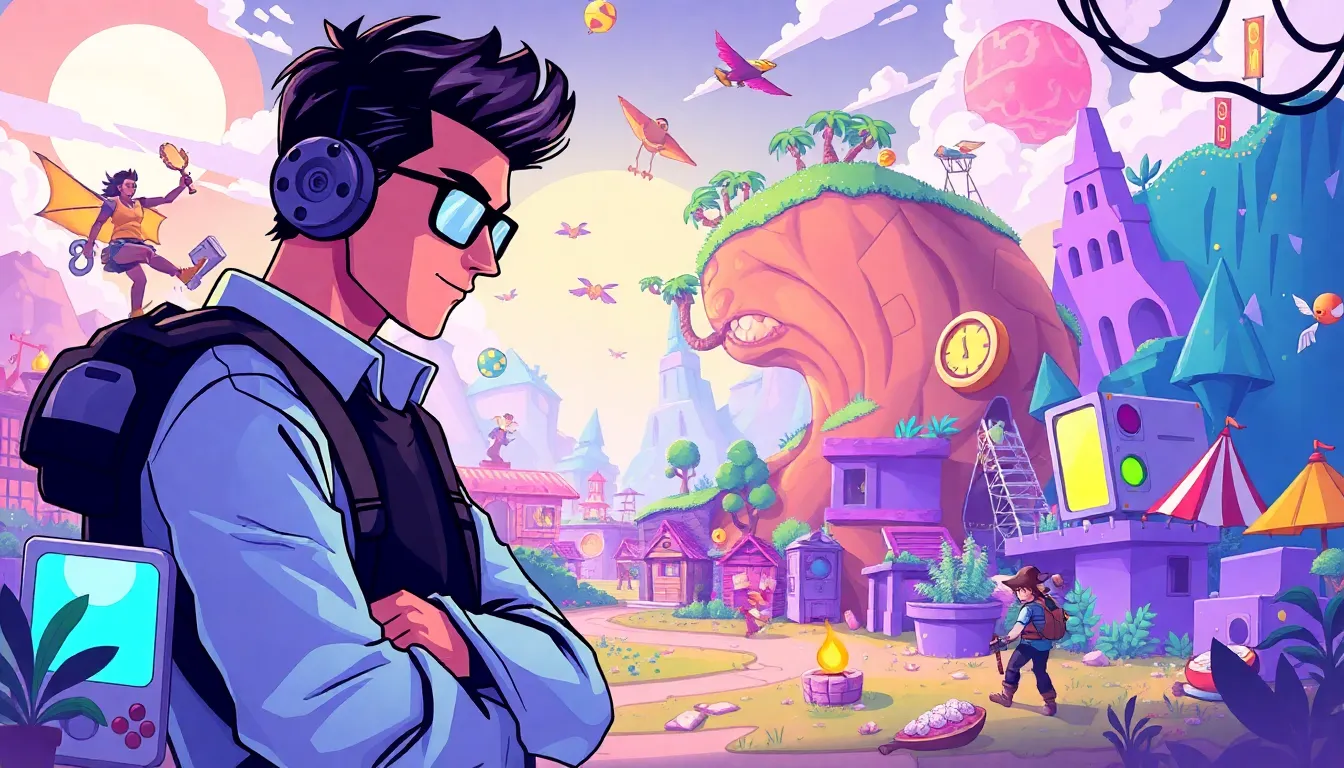Indie games have taken the gaming world by storm, proving that creativity often trumps big budgets. These gems, crafted by passionate developers, offer unique experiences that can make even the most seasoned gamers giggle with joy—or frustration. From pixelated adventures to mind-bending puzzles, indie games cater to every taste, often leaving players wondering why they ever settled for mainstream titles.
Most Popular Indie Games
Indie games represent a significant trend in the gaming industry, showcasing innovative designs and narratives. Many developers embrace creativity, often prioritizing artistic expression over financial gain. These games frequently feature unique mechanics and visual styles, which can differ starkly from mainstream titles.
Players encounter various genres within indie games, including platformers, adventure games, and role-playing games. Each genre offers diverse experiences, contributing to the overall charm of indie gaming. Titles like “Celeste” and “Hollow Knight” illustrate how well-crafted gameplay captures players’ attention and emotions.
Indie developers often choose to distribute their games through digital marketplaces, including Steam and itch.io. Lower distribution costs enable these creators to reach a broader audience. As a result, several indie games have gained critical acclaim and commercial success, attracting players who seek alternatives to blockbuster franchises.
Community engagement serves as another foundation for indie game success. Through feedback on forums and social media, developers can refine their games based on players’ insights. This interaction helps build a loyal fanbase that supports growth and development in indie gaming.
The rise of crowdfunding platforms, such as Kickstarter, has also fueled indie game projects. Developers can secure funding for their visions, allowing them to invest in game design and marketing. This model empowers creators to bring unique ideas to life without relying solely on traditional publishers.
As indie games continue to evolve, they challenge conventional gaming norms and push boundaries. Unique storytelling and experimental gameplay resonate with players, making the indie gaming scene an exciting space within the larger industry.
Factors Contributing to Popularity

Indie games gain traction due to distinct characteristics that set them apart from mainstream titles.
Unique Art Styles
Players often appreciate the diverse artistic expressions found in indie games. Artistic innovation frequently shines through vibrant visuals and distinctive designs. Developers utilize styles ranging from pixel art to hand-drawn illustrations. Games like “Cuphead” showcase a 1930s cartoon aesthetic, while “Gris” features watercolor-inspired graphics. Such unique art forms attract gamers seeking fresh visual experiences. Players find themselves emotionally connected to the art, enhancing their overall enjoyment and immersion.
Innovative Gameplay Mechanics
Indie games frequently introduce groundbreaking gameplay mechanics that diverge from traditional norms. Creative developers experiment with novel concepts, challenging player expectations. Titles like “Untitled Goose Game” employ simple yet engaging mechanics, encouraging exploration and interaction. Others, such as “Dead Cells,” combine roguelike elements with fast-paced action. Gameplay often prioritizes player agency, allowing freedom to approach challenges in various ways. Innovative mechanics resonate with audiences and promote memorable experiences, contributing to an indie game’s wide appeal.
Top 5 Most Popular Indie Games
Indie games have carved a significant niche within the gaming landscape, capturing players’ hearts with unique gameplay and creative storytelling. Here’s a look at five standout titles that exemplify the innovation present in the indie scene.
Game 1: Hades
Hades redefined the rogue-like genre with its engaging narrative and fluid combat. Players control Zagreus, the son of Hades, as he attempts to escape the Underworld. The dynamic character interactions unfold through each attempt, enhancing player investment in the story. This title earned acclaim for its beautiful art style and exceptional voice acting, creating an immersive experience. Over 1 million copies sold within its first year, highlighting its massive popularity among gamers.
Game 2: Hollow Knight
Hollow Knight captivates players with its intricate world and deep lore. Set in the hauntingly beautiful Hallownest, players navigate platforms, defeat formidable foes, and uncover secrets. This action-adventure game stands out for its hand-drawn visuals and atmospheric soundtrack. Its challenging gameplay rewards exploration and skillful combat, appealing to players seeking depth. With over 3 million copies sold, it remains a favorite in the indie community.
Game 3: Celeste
Celeste combines platforming challenges with poignant storytelling in a pixel art format. Players guide Madeline as she climbs the titular mountain, confronting personal hardships along the way. Its precise controls and creative level design engage players while making each triumph feel rewarding. Celeste earned accolades for addressing mental health themes, resonating strongly with gamers. Sales surpassed 1 million copies, solidifying its status as a beloved indie title.
Game 4: Stardew Valley
Stardew Valley offers a relaxing farming simulation experience infused with character-driven narratives. Players develop their own farms, raise animals, and interact with townsfolk, fostering relationships. This title stands out for its charming pixel art style and laid-back gameplay mechanics. Players customize their farming strategies, leading to varied experiences in every playthrough. Selling over 10 million copies, it remains a pillar of the indie gaming renaissance.
Game 5: Undertale
Undertale breaks conventional RPG norms by allowing players to choose non-violent solutions to conflicts. This narrative-driven game features quirky characters and an innovative combat system that emphasizes choices. Players engage with a variety of endings based on their decisions, increasing replay value. Its unique charm and humor appeal to diverse audiences. With over 6 million copies sold, Undertale has solidified its place in indie gaming history.
Impact of Indie Games on the Gaming Industry
Indie games significantly shape the gaming landscape, fostering creativity and innovation. Unique gameplay experiences emerge from developers who prioritize artistic expression over financial constraints. Such titles often introduce groundbreaking gameplay mechanics that grab players’ attention.
Cultural impact becomes evident as these games tell diverse stories and explore intricate themes. For instance, “Undertale” breaks traditional RPG norms, while “Cuphead” blends nostalgia with challenging mechanics. This diversity helps cultivate a strong emotional connection between players and the game worlds.
Distribution methods also play a crucial role in the success of indie games. Digital marketplaces like Steam and itch.io expand the reach of these titles, tapping into global audiences. Crowdfunding platforms empower developers to fund creative projects, promoting unique ideas without relying on large publishers.
Community engagement enhances the indie gaming experience. Developers refine their games based on player feedback, nurturing loyalty among fans. This sense of collaboration often leads to content updates and expansions that keep players invested over time.
Recognition of indie games not only affects developers but also the larger industry. Their success prompts major studios to adopt innovative ideas and embrace fresh perspectives. By challenging conventional norms, indie games catalyze innovation and inspire mainstream titles.
Indie games continue to thrive in a competitive market. Their distinct visual styles and memorable narratives create opportunities for players to explore new genres. The industry’s growth largely hinges on these games, as they consistently demonstrate that creativity resonates with audiences worldwide.
Conclusion
The indie gaming scene continues to flourish as it champions creativity and innovation. With each new title, developers push the boundaries of storytelling and gameplay, captivating players in ways that mainstream games often overlook. The emotional connections forged through unique narratives and art styles create lasting impressions.
As the industry evolves, the influence of indie games becomes increasingly significant. They not only inspire major studios to embrace fresh ideas but also encourage a diverse gaming culture that values artistic expression. The future of gaming looks bright with indie developers leading the charge, inviting players to explore a world rich with imagination and originality.




